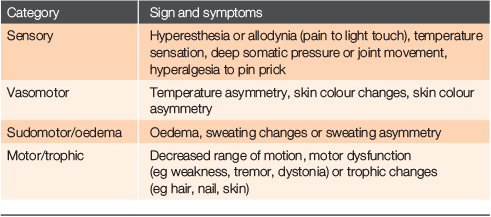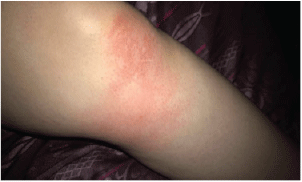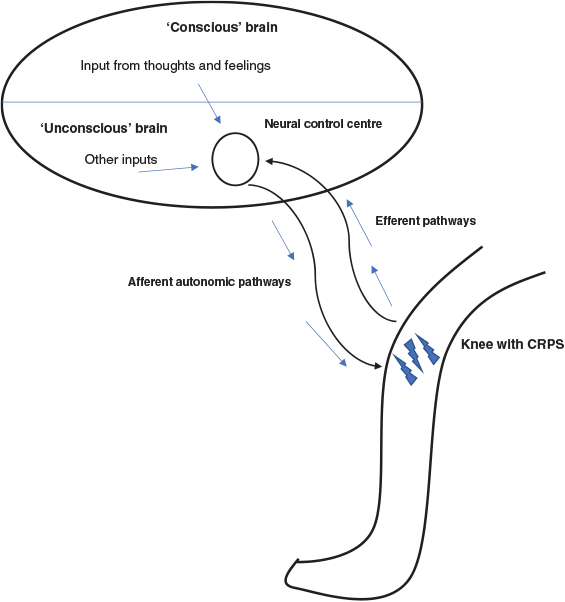Emerging models for successful treatment of complex regional pain syndrome in children and young adults
John Dunbar 1 , Hamish Wilson 2 31 Department of Orthopaedics, Healthcare Otago, Dunedin 9016, New Zealand
2 Otago Medical School, University of Otago, PO Box 913, Dunedin 9016, New Zealand
3 Corresponding author. Email: Hamish.wilson@otago.ac.nz
Journal of Primary Health Care 11(3) 283-287 https://doi.org/10.1071/HC19025
Published: 20 September 2019
Journal Compilation © Royal New Zealand College of General Practitioners 2019 This is an open access article licensed under a Creative Commons Attribution-NonCommercial-NoDerivatives 4.0 International License
Abstract
Complex regional pain syndrome (CRPS) is a relatively common condition that is often not well recognised or treated adequately. Patients are usually referred to multidisciplinary pain services, but outcomes remain variable. This case report describes a recent patient with CRPS who was treated quickly and effectively through a simple explanation of the relationship between mind and body, and who then was able to modify her own thought processes and behaviours. This single intervention enabled a complete resolution of symptoms. This report illustrates the clinical application of recent insights into neuroplasticity and individually tailored patient self-management that may now offer successful treatment of an otherwise chronic and disabling condition, especially in younger patients. There are implications for doctors in current practice, as well as for the training of medical students and junior doctors.
| WHAT GAP THIS FILLS |
| What is already known: Complex regional pain syndrome (CRPS) is relatively common, but it is not widely understood and is often difficult to manage. |
| What this study adds: This paper outlines the illness and recovery of a recent patient with CRPS who was representative of many other patients in the lead author’s orthopaedic practice. Successful treatment drew on emerging concepts in neurophysiology and patient self-management that may now offer fresh hope for patients with this condition. |
Introduction
Complex regional pain syndrome (CRPS) is characterised by paradoxically increasing pain and disability out of proportion to the original injury or trauma.1 Swelling and changes in colour, temperature and skin sensitivity suggest underlying autonomic dysfunction in a regional area of a limb such as a knee or foot. Female patients aged 7–60 years are most often affected. The condition has previously been termed ‘reflex sympathetic dystrophy’ or ‘causalgia,’ but consensus statements now favour using CRPS as defined by the ‘Budapest’ criteria (see Table 1).2,3 Despite the usual range of currently available medical and surgical interventions, many patients have persisting pain and disability.

|
Case report
A 15-year-old female patient presented to the first author (J. Dunbar) with an 18-month history of a painful left knee. Even with crutches and a knee brace, she was partially weight bearing on her toes only. There was a purplish skin colour over her knee and foot, with markedly wasted quadriceps. Pain prevented full knee extension or a complete examination of her patellofemoral joint.
Eighteen months previously, she had three minor twists of her knee. After each injury, her knee became more sore, so she started using crutches. Treatment had included physiotherapy, a cortisone injection and the suggestion of surgery from an orthopaedic surgeon.
At this consultation, the patient described ongoing severe pain and sensitivity around her patella. Simple events such as a dog jumping up or clothes rubbing on her knee could be quite uncomfortable. She was struggling to sleep due to pain, often staying awake until 1 am. She had noticed a red and purplish skin discoloration over her knee and foot for many months, and the foot tended to swell, even when resting (Fig. 1). Sometimes, there was numbness and tingling around her knee and foot, which often felt cold. She had given up taking pain killers as they were ineffective. A diagnosis of complex regional pain syndrome was made as the symptoms and signs satisfied the Budapest diagnostic criteria.

|
Treatment was initiated during this consultation. Initially, the patient was reassured that the mechanics of her patellofemoral joint were good and that surgery was not required, noting that a previous MRI scan 6 months after her injury was normal. She was informed how it is possible to experience severe pain without significant tissue damage being present. This explanation involved a simple description of nerve pathways and factors contributing to pain, including an outline of how the brain usually processes incoming information, and how it then responds. A key educational strategy was a drawing to illustrate how pain and autonomic features can sometimes develop in the absence of structural knee damage, which then inhibit the normal healing process (Fig. 2). This model was then used to describe strategies the patient could use, such as visualising a block to the hypersensitive efferent nerve pathways between her leg and brain, which were now contributing to her pain and disability.

|
The only medication prescribed was a short course of melatonin to help restore sleep, although she could also use simple analgesics if helpful. The initial consultation and discussion about self-management strategies took 75 min.
The patient was seen again after 16 days. Progress had been rapid. The pain had largely subsided and she had mostly been walking without crutches. As the pain subsided, the autonomic signs of swelling, colour change and cold or tingling feelings disappeared.
A further consultation was held 5 weeks after the initial meeting. The patient had stopped using crutches, but was understandably limited by leg weakness. Her progress was sufficiently good that no further follow up was thought necessary, although she was seen for the purpose of this article 21 months later. She reported some aching in her knee when it was cold, but otherwise there had been no recurrence of any symptoms.
Discussion
Transient features of CRPS are quite common, occurring in up to 25% of minor limb injuries.1 A low proportion of those patients then develop major disability and chronic pain. Among adult patients, 15% have unrelenting pain and major physical impairment more than 5 years after onset, despite traditional treatment. Many more patients have lesser but ongoing degrees of disability.
Similar to other complex or atypical presentations, many patients are not diagnosed accurately in the early stages and even if they are, feelings of frustration and uncertainty often develop in both patient and doctor.4 Doctors may feel powerless and inadequate and often refer such patients for further investigations or opinions.5 As illustrated in this example, patients can become stuck in a fruitless succession of medical appointments without resolution of problems. This may lead to withdrawal from seeking medical help, feelings of despondency and self-doubt.6
In 2011, the Royal College of Physicians published guidelines for CRPS in adults that recommended management based on physiotherapy to maintain function, multidisciplinary education through specialist pain clinics, vocational rehabilitation and psychological input.3 However, the guidelines also included a concerning statement that ‘There is no medical cure for CRPS.’ The diagnostic criteria for CRPS in children are the same as those for adults, but this case report illustrates that children and young adults may respond differently and that a ‘cure’ for CRPS is possible.
New models of care for chronic pain are now emerging.7 These advocate holistic and integrated patient-centred care, emphasising the importance of patients’ stories, emotional responses to trauma, mind–body connections and the psycho–neuro-immunology of pain. It is important that both clinician and patient are aware of the fundamental concept of neuroplasticity:8 that neuro–physiological pathways can change for better or worse, and can be influenced through patient self-management. Changes to normal or existing pathways can contribute to the development of chronic pain, but given sufficient reassurance, explanation and coaching about these hypersensitive neural pathways and how they can be modified, patients can self-correct, leading to improvement and even resolution of pain or autonomic symptoms.9 For example, the patient in this report responded well to an initial reassurance that there was a potential cure for her CRPS. She accepted the challenge that if she did her ‘homework’ regularly based on the instruction she had received, she had the power to improve her symptoms.
The approach to CRPS described in this case report has produced complete resolution of symptoms within a few weeks in many other children and teenagers treated by the first author (J. Dunbar). Young people appear to accept these emerging explanations for their complex and chronic symptoms with little reservation, demonstrating high capacity for self-modified neuroplasticity. The same mind–body techniques can work well for adults as well, especially if patients are able to change their mindset away from a strict biomedical model, and if there are no other psychosocial drivers of pain. While older adults may not recover fully, they can be helped to regain more functional capacity.
Other explanatory models have also been described.9 These models can be applied to pain syndromes as well as to other conditions that have previously been referred to as ‘medically unexplained symptoms’, ‘somatisation’ or ‘functional illness.’ Although many doctors are not well trained or feel inexperienced in these areas of practice, there is now increasing evidence for efficacy of these emerging paradigms of mind–body management.10
Implications
For clinicians, application of the approaches we suggest will require a substantial change in mindset away from established models of pain and disability; it is not always easy to believe how well such approaches can work until successful results are observed. The explanatory models and coaching techniques require careful thought and practice, but they can become a satisfying skill in clinical practice. Through learning from such patients and through well-focused continuing medical education sessions, doctors in all specialities can develop similar skills to apply with well-chosen patients.
There are also important implications for medical training. Medical students and junior doctors can now learn about these emerging approaches to the treatment of complex pain and other atypical syndromes. To prevent negative attitudes to such patients developing in trainees,11 medical curricula need to be flexible enough to accommodate recent advances in understanding of neuroplasticity and the role of patients in self-management. With sufficient skill in these techniques, future clinicians may be able to offer considerable hope to some patients who have otherwise been told ‘there is no cure.’
Competing interests
The authors declare no conflicts of interest.
Funding
This research did not receive any specific funding.
References
[1] Turner-Stokes L, Goebel A. Complex regional pain syndrome in adults: concise guidance. Clin Med (Lond). 2011; 11 596–600.| Complex regional pain syndrome in adults: concise guidance.Crossref | GoogleScholarGoogle Scholar | 22268318PubMed |
[2] Rief W, Broadbent E. Explaining medically unexplained symptoms – models and mechanisms. Clin Psychol Rev. 2007; 27 821–41.
| Explaining medically unexplained symptoms – models and mechanisms.Crossref | GoogleScholarGoogle Scholar | 17716793PubMed |
[3] Goebel A, Barker C, Turner-Stokes L, et al. Complex regional pain syndrome in adults: UK guidelines for diagnosis, referral and management in primary and secondary care. London: Royal College of Physicians; 2012.
[4] Maatz A, Wainwright M, Russell AJ, et al. What’s ‘difficult’? A multi-stage qualitative analysis of secondary care specialists’ experiences with medically unexplained symptoms. J Psychosom Res. 2016; 90 1–9.
| What’s ‘difficult’? A multi-stage qualitative analysis of secondary care specialists’ experiences with medically unexplained symptoms.Crossref | GoogleScholarGoogle Scholar | 27772554PubMed |
[5] Stone L. Blame, shame and hopelessness: medically unexplained symptoms and the ‘heartsink’ experience. Aust Fam Physician. 2014; 43 191–5.
| 24701621PubMed |
[6] Nettleton S. ‘I just want permission to be ill’: towards a sociology of medically unexplained symptoms. Soc Sci Med. 2006; 62 1167–78.
| ‘I just want permission to be ill’: towards a sociology of medically unexplained symptoms.Crossref | GoogleScholarGoogle Scholar | 16135395PubMed |
[7] Hayes C, Hodson FJ. A whole-person model of care for persistent pain: from conceptual framework to practical application. Pain Med. 2011; 12 1738–49.
| A whole-person model of care for persistent pain: from conceptual framework to practical application.Crossref | GoogleScholarGoogle Scholar | 22054224PubMed |
[8] Burton C, Lucassen P, Aamland A, Hartman T. Explaining symptoms after negative tests: towards a rational explanation. J R Soc Med. 2015; 108 84–8.
| Explaining symptoms after negative tests: towards a rational explanation.Crossref | GoogleScholarGoogle Scholar | 25389231PubMed |
[9] van Ravenzwaaij J, Olde Hartman TC, Van Ravesteijn H, et al. Explanatory models of medically unexplained symptoms: a qualitative analysis of the literature. Ment Health Fam Med. 2010; 7 223–31.
| 22477946PubMed |
[10] Espay AJ, Aybek S, Carson A, et al. Current concepts in diagnosis and treatment of functional neurological disorders. JAMA Neurol. 2018; 75 1132–41.
| 29868890PubMed |
[11] Shattock L, Williamson H, Caldwell K, et al. ‘They’ve just got symptoms without science’: Medical trainees’ acquisition of negative attitudes towards patients with medically unexplained symptoms. Patient Educ Couns. 2013; 91 249–54.
| ‘They’ve just got symptoms without science’: Medical trainees’ acquisition of negative attitudes towards patients with medically unexplained symptoms.Crossref | GoogleScholarGoogle Scholar | 23369375PubMed |


